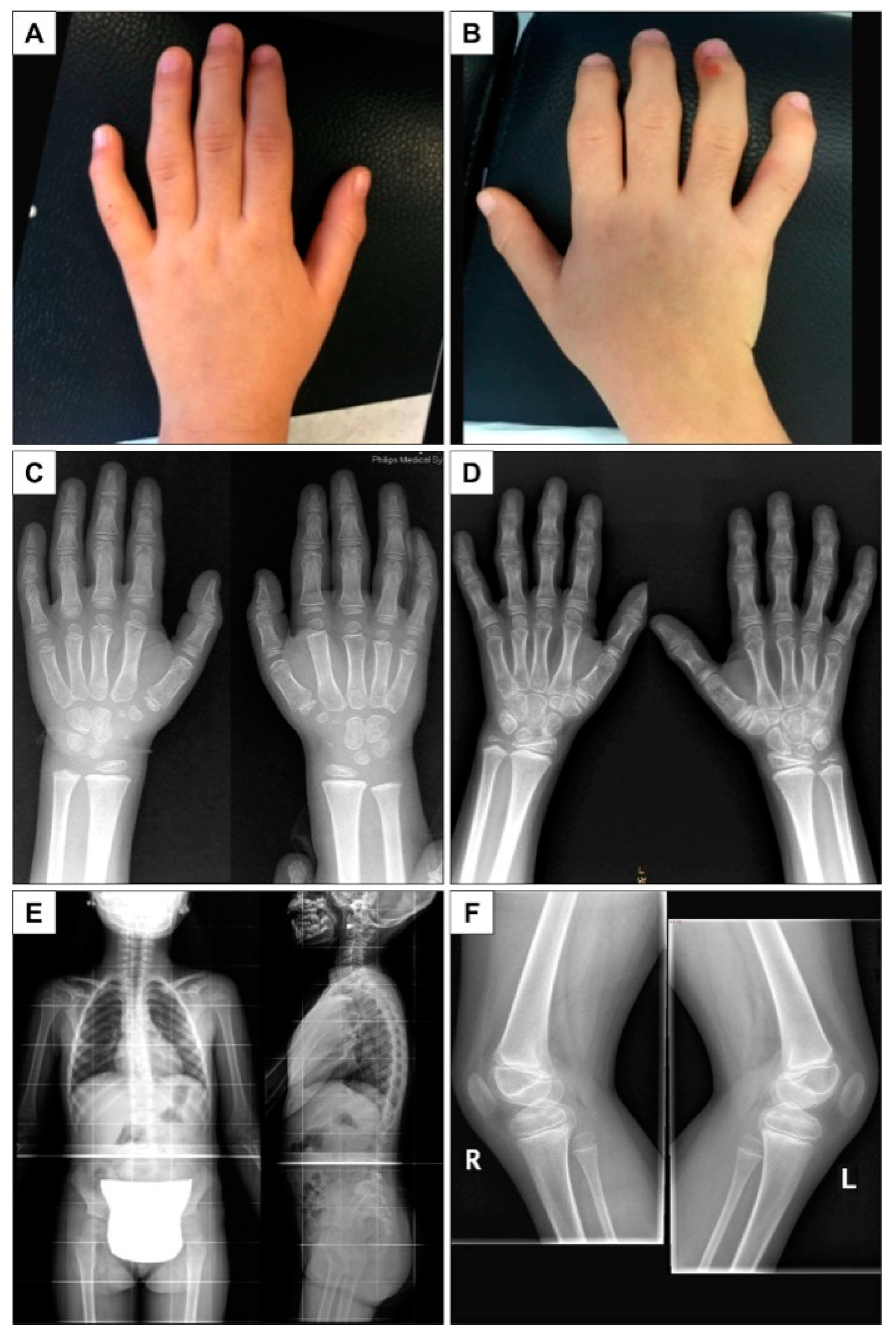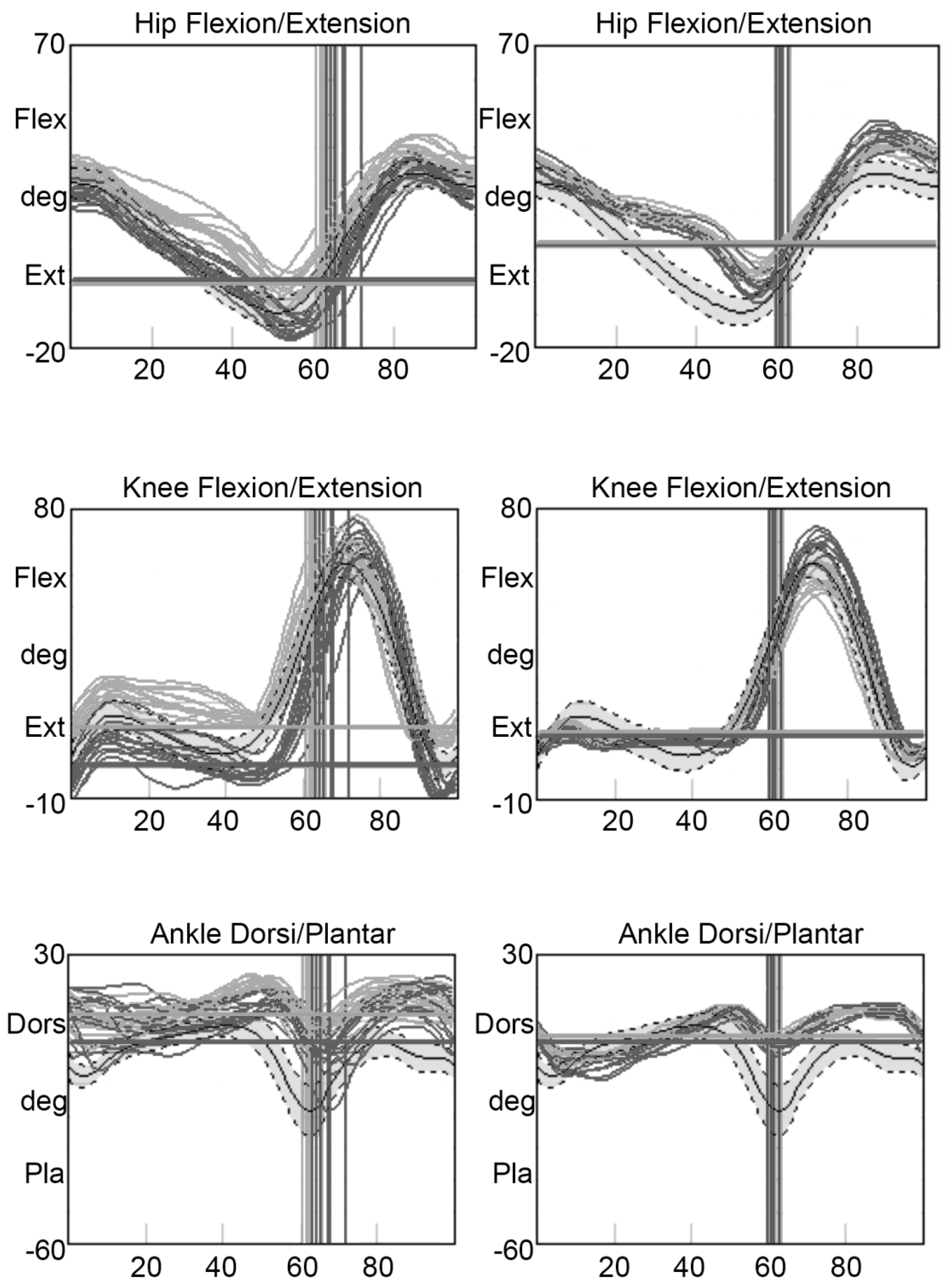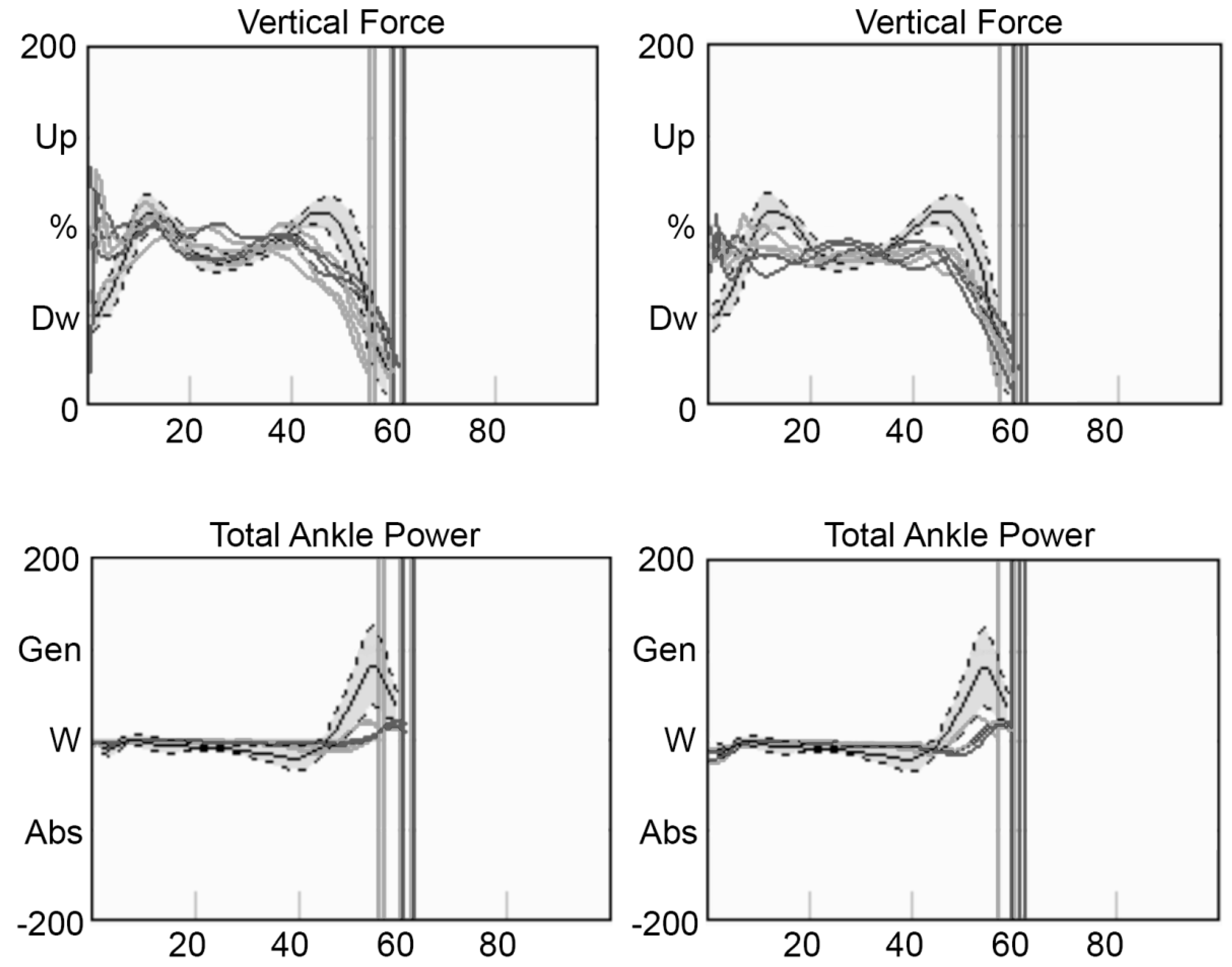Gait Alterations in Two Young Siblings with Progressive Pseudorheumatoid Dysplasia
Abstract
:1. Background
2. Case Presentation
3. Discussion and Conclusions
Author Contributions
Funding
Institutional Review Board Statement
Informed Consent Statement
Data Availability Statement
Acknowledgments
Conflicts of Interest
References
- Torreggiani, S.; Torcoletti, M.; Campos-Xavier, B.; Baldo, F.; Agostoni, C.; Superti-Furga, A.; Filocamo, G. Progressive pseudorheumatoid dysplasia: A rare childhood disease. Rheumatol. Int. 2019, 39, 441–452. [Google Scholar] [CrossRef] [PubMed]
- Ye, J.; Zhang, H.W.; Qiu, W.J.; Han, L.S.; Zhang, Y.F.; Gong, Z.W.; Gu, X.F. Patients with progressive pseudorheumatoid dysplasia: From clinical diagnosis to molecular studies. Mol. Med. Rep. 2012, 5, 190–195. [Google Scholar] [CrossRef] [PubMed]
- Garcia Segarra, N.; Mittaz, L.; Campos-Xavier, A.B.; Bartels, C.F.; Tuysuz, B.; Alanay, Y.; Cimaz, R.; Cormier-Daire, V.; Di Rocco, M.; Duba, H.C.; et al. The diagnostic challenge of progressive pseudorheumatoid dysplasia (PPRD): A review of clinical features, radiographic features, and WISP3 mutations in 63 affected individuals. Am. J. Med. Genet. C Semin. Med. Genet. 2012, 160, 217–229. [Google Scholar] [CrossRef] [PubMed]
- Legius, E.; Mulier, M.; Van Damme, B.; Fryns, J.P. Progressive pseudorheumatoid arthritis of childhood (PPAC) and normal adult height. Clin. Genet. 1993, 44, 152–155. [Google Scholar] [CrossRef] [PubMed]
- Hurvitz, J.R.; Suwairi, W.M.; Van Hul, W.; El-Shanti, H.; Superti-Furga, A.; Roudier, J.; Holderbaum, D.; Pauli, R.M.; Herd, J.K.; Van Hul, E.V.; et al. Mutations in the CCN gene family member WISP3 cause progressive pseudorheumatoid dysplasia. Nat. Genet. 1999, 23, 94–98. [Google Scholar] [CrossRef] [PubMed]
- Yang, G.P.; Lau, L.F. Cyr61, product of a growth factor-inducible immediate early gene, is associated with the extracellular matrix and the cell surface. Cell Growth Differ. 1991, 2, 351–357. [Google Scholar] [PubMed]
- Kireeva, M.L.; Latinkic, B.V.; Kolesnikova, T.V.; Chen, C.C.; Yang, G.P.; Abler, A.S.; Lau, L.F. Cyr61 and Fisp12 are both ECM-associated signaling molecules: Activities, metabolism, and localization during development. Exp. Cell Res. 1997, 233, 63–77. [Google Scholar] [CrossRef] [PubMed]
- Lau, L.F.; Lam, S.C. The CCN family of angiogenic regulators: The integrin connection. Exp. Cell Res. 1999, 248, 44–57. [Google Scholar] [CrossRef] [PubMed]
- Dalal, A.; Bhavani, G.S.L.; Togarrati, P.P.; Bierhals, T.; Nandineni, M.R.; Danda, S.; Danda, D.; Shah, H.; Vijayan, S.; Gowrishankar, K.; et al. Analysis of the WISP3 gene in Indian families with progressive pseudorheumatoid dysplasia. Am. J. Med. Genet. 2012, 158, 2820–2828. [Google Scholar] [CrossRef] [PubMed]
- Ekbote, A.V.; Danda, D.; Kumar, S.; Danda, S.; Madhuri, V.; Gibikote, S. A descriptive analysis of 14 cases of progressive-psuedorheumatoid-arthropathy of childhood from south India: Review of literature in comparison with juvenile idiopathic arthritis. Semin. Arthritis Rheum. 2013, 42, 582–589. [Google Scholar] [CrossRef] [PubMed]
- Spranger, J.; Albert, C.; Schilling, F.; Bartsocas, C. Progressive pseudorheumatoid arthropathy of childhood (PPAC): A hereditary disorder simulating juvenile rheumatoid arthritis. Am. J. Med. Genet. 1983, 14, 399–401. [Google Scholar] [CrossRef] [PubMed]
- Al Kaissi, A.; Kenis, V.; Jemaa, L.B.; Sassi, H.; Shboul, M.; Grill, F.; Ganger, R.; Kircher, S.G. Skeletal phenotype/genotype in progressive pseudorheumatoid chondrodysplasia. Clin. Rheumatol. 2020, 39, 553–560. [Google Scholar] [CrossRef]
- Leardini, A.; Sawacha, Z.; Paolini, G.; Ingrosso, S.; Nativo, R.; Benedetti, M.G. A new anatomically based protocol for gait analysis in children. Gait Posture 2007, 26, 560–571. [Google Scholar] [CrossRef]
- Hartmann, M.; Merker, J.; Haefner, R.; Haas, J.P.; Schwirtz, A. Biomechanics of walking in adolescents with progressive pseudorheumatoid arthropathy of childhood leads to physical activity recommendations as therapeutic focus. Clin. Biomech. 2016, 31, 93–99. [Google Scholar] [CrossRef] [PubMed]
- Perry, J. Gait Analysis: Normal and Pathological Function; SLACK Incorporated: Thorofare, NJ, USA, 2010. [Google Scholar]
- Bazarnik-Mucha, K.; Snela, S.; Szczepanik, M.; Jarmuziewicz, A.; Guzik, A.; Wolinska, O.; Druzbicki, M. Three-dimensional analysis of gait in children and adolescents with juvenile idiopathic arthritis. Acta Bioeng. Biomech. 2020, 22, 35–45. [Google Scholar] [CrossRef] [PubMed]
- Oda, S.; Izumi, M.; Takaya, S.; Tadokoro, N.; Aso, K.; Petersen, K.K.; Ikeuchi, M. Promising Effect of Visually-Assisted Motor Imagery Against Arthrogenic Muscle Inhibition—A Human Experimental Pain Study. J. Pain Res. 2021, 14, 285–295. [Google Scholar] [CrossRef] [PubMed]




| Boy | Girl | |
|---|---|---|
| Age | 4 | 9 |
| Height (cm) | 101 | 114 |
| Weight (kg) | 16 | 20 |
| BMI (kg/m2) | 15.68 | 15.39 |
| PROM—Left/Right Hip (deg) | Ext Rot 60; Int Rot 45 (bil) | Ext Rot 30/40; Int R 30/30 |
| PROM—Left/Right Knee (deg) | Complete | −5 (bil) |
| PROM—Left/Right Ankle (deg) | 20–50 | 20–50 |
| Popliteal Angle—Left/Right (deg) | 30 (bil) | 20 (bil) |
| Pain | No | No |
| Inter-Phalangeal Deformity | Yes | Yes |
| Fatigability | Yes | Yes |
| Boy | Girl | |||
|---|---|---|---|---|
| Left Side | Right Side | Left Side | Right Side | |
| 1 Double Support (%) | 12.6 ± 1.5 | 13.1 ± 3.1 | 11.6 ± 1 | 11.7 ± 1.3 |
| Single Support (%) | 39.7 ± 2.6 | 35.3 ± 3.9 | 38.6 ± 1.3 | 38.4 ± 1.5 |
| 2 Double Support (%) | 13.2 ± 2.3 | 12.9 ± 1.3 | 11.7 ± 0.8 | 11.8 ± 1 |
| Cadence (steps/min) | 75.6 ± 4.1 | 75.1 ± 3.9 | 71.2 ± 4.6 | 72.0 ± 5.3 |
| Cycle Time (s) | 0.80 ± 0.05 | 0.80 ± 0.04 | 0.85 ± 0.05 | 0.84 ± 0.06 |
| Speed (cm/s) | 90.4 ± 9.3 | 91.0 ± 10.8 | 96.1 ± 11.0 | 96.6 ± 10.2 |
| Stance Time (%) | 65.2 ± 2.6 | 61.2 ± 1.9 | 61.9 ± 0.8 | 61.1 ± 1.5 |
| Stride Length (cm) | 71.6 ± 3.9 | 72.6 ± 5.7 | 80.8 ± 4.5 | 80.4 ± 3.7 |
Publisher’s Note: MDPI stays neutral with regard to jurisdictional claims in published maps and institutional affiliations. |
© 2022 by the authors. Licensee MDPI, Basel, Switzerland. This article is an open access article distributed under the terms and conditions of the Creative Commons Attribution (CC BY) license (https://creativecommons.org/licenses/by/4.0/).
Share and Cite
Sassi, S.; Faccioli, S.; Farella, G.M.; Tedeschi, R.; Garavelli, L.; Benedetti, M.G. Gait Alterations in Two Young Siblings with Progressive Pseudorheumatoid Dysplasia. Children 2022, 9, 1982. https://doi.org/10.3390/children9121982
Sassi S, Faccioli S, Farella GM, Tedeschi R, Garavelli L, Benedetti MG. Gait Alterations in Two Young Siblings with Progressive Pseudorheumatoid Dysplasia. Children. 2022; 9(12):1982. https://doi.org/10.3390/children9121982
Chicago/Turabian StyleSassi, Silvia, Silvia Faccioli, Giuseppina Mariagrazia Farella, Roberto Tedeschi, Livia Garavelli, and Maria Grazia Benedetti. 2022. "Gait Alterations in Two Young Siblings with Progressive Pseudorheumatoid Dysplasia" Children 9, no. 12: 1982. https://doi.org/10.3390/children9121982
APA StyleSassi, S., Faccioli, S., Farella, G. M., Tedeschi, R., Garavelli, L., & Benedetti, M. G. (2022). Gait Alterations in Two Young Siblings with Progressive Pseudorheumatoid Dysplasia. Children, 9(12), 1982. https://doi.org/10.3390/children9121982






